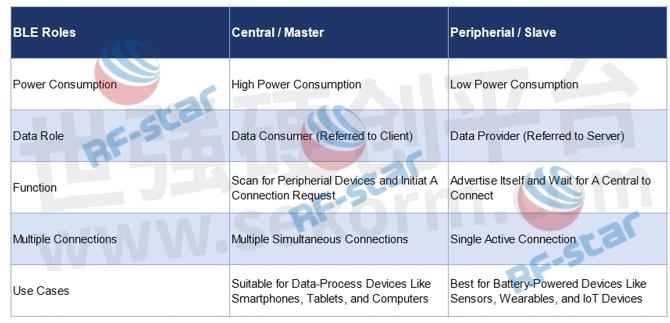BLE Connection Roles Central/Master vs. Peripheral/Slave

Learn the nuances between Central and Peripheral roles in BLE devices to optimize energy efficiency and functionality for your projects. Unlock how to select the most suitable BLE Modules based on your specific needs.
In the world of Bluetooth Low Energy (BLE), BLE devices are designed to play specific roles that dictate how they interact within the BLE ecosystem. To fully leverage the benefits of BLE technology, it is essential to understand the roles of BLE devices in the communication process.

Fig.1
In this article, we introduce the common roles in BLE connection, the differences between Central and Peripheral roles, and how to choose well-suited BLE modules for your projects. The two primary BLE roles are the Central and Peripheral roles.
Central / Master vs. Peripheral / Slave
The Central is a device with powerful and rich resources. The BLE central device initiates an outgoing connection request to an advertising peripheral device, and processes data provided by the peripheral. In a way, it can be regarded as the active role, also referred to as a “master”. A typical example of a central device is a smartphone, which can connect to several peripherals simultaneously, collecting, and processing data from each.
On the other hand, the Peripheral is a typically low-power, resource-constrained device that provides data. It accepts an incoming connection request after advertising its presence to other devices in the vicinity. Generally, the Peripheral is meant to stay put until someone decides to connect with it. Hence, it is also called a “slave”. A peripheral is usually a small device like a smartwatch, a temperature sensor, a heart rate monitor, etc.
The BLE specification does not limit the number of slaves a master may connect to, but there is always a practical limitation, especially on different models of modules. For instance, RF-Star’s BLE modules based on TI CC2642R, CC2340, Silicon Labs EFR32BG22 and Nordic nRF52840 nRF52832 SoCs play a master and multi-slave roles. Support at most 8 simultaneous and stable connection devices, that is 7 slaves and 1 master. Furthermore, the EFR32BG22 and CC2340-based Bluetooth Low Energy modules can connect simultaneously to multiple masters and slave devices.
After knowing the definition of connection roles in BLE communication, let’s move to their distinction.
Differences Between Central and Peripheral
While BLE Peripherals and Centrals both contribute to BLE communication, they have unique features, capabilities, and requirements. Here is a table for you to clearly distinguish each other.
Table.1

As the above shows, a Peripheral in BLE is a low-power device, mainly providing data. It wakes up only to advertise or transmit data while spending most of the time in a low-power sleep mode. A Central, in contrast, is power-hungry, continuously scanning for peripherals and managing multiple connections. Some Central devices, like smartphones, can maintain several connections simultaneously, making them suitable for data aggregation and processing, whereas peripherals are commonly found in battery-powered devices like sensors, wearables, and beacons.
Knowing these differences, is it clear how to choose between a master and slave role for your BLE device? Don’t worry! RF-star lists some useful suggestions for a better choice of your specific needs.
Tips for Choosing Master and Slave BLE Modules
Energy Efficiency Priority: Determine if energy conservation is a top priority for your device. If so, opting for a BLE module acting as a slave may be advantageous, because it primarily operates in a low-power mode.
Data Role: Assess whether your device primarily generates data for consumption by other devices or needs to collect and process data from peripherals. Devices that generate data are better embedded by slave BLE modules, while those that collect data are more apt as masters.
Multi-Device Connectivity: Consider whether your device needs to connect with multiple other devices simultaneously. If so, functioning as a master device would be more effective in managing multiple connections concurrently.
Resource Allocation: Evaluate the processing power and resources available on your device. If resources are limited, choosing a slave module may be more feasible as a master BLE module typically requires more processing power and resources to manage multiple connections.
Tailored Application Needs: Analyze the specific requirements of your application to determine the most suitable role for your device. For example, a health tracker (peripheral) needs to transmit data to a smartphone (central), while a smart home hub (central) must gather data from various home automation sensors (peripherals).
Consider Scalability: Think about potential future requirements and the scalability of your device. If your device will need to connect to more peripherals or handle increased data processing in the future, a BLE module operating as a master role might offer greater flexibility.
Ease of Integration: Consider how seamlessly your device needs to integrate into existing BLE ecosystems. Depending on the ecosystem and compatibility requirements, choosing the appropriate role can facilitate smoother integration and interoperability with other devices.
User Interaction Patterns: Estimate the typical user interaction patterns with your device. If users are more likely to interact directly with your device (e.g., through a smartphone app), it may be better suited as a master. Conversely, if the device operates autonomously with minimal user interaction, a slave role might be better.
Fortunately, as diverse demands grow and BLE technology advances, more and more master-slave Bluetooth modules have emerged on the market. With their dual-role capability, these modules can reduce overall application costs and enhance usability, making project optimization easier.
- +1 Like
- Add to Favorites
Recommend
- EFR32BG22 Wireless SoC Enables IoT Devices to Operate 10+ Years on 1 Conin Cell Battery | Silicon Labs
- Silicon Labs and Wirepas Enable IoT for Asset Tracking and Building Automation
- Silicon Labs’ Portfolio Includes SoCs Suited for Portable Medical Devices and Diabetes Management
- Silicon Labs Announces New Bluetooth® Location Services with Advanced Hardware and Software
- Silicon Labs’ Product Portfolio Maximizes New Bluetooth 5.4 Features, Facilitating IoT Applications Development
- Bluetooth direction finding brings a new dimension to indoor asset tracking
- Bluetooth tag connects and tracks construction assets wirelessly, increasing productivity and reducing maintenance costs
- 8 High-Power Bluetooth LE Modules and Their Applications
This document is provided by Sekorm Platform for VIP exclusive service. The copyright is owned by Sekorm. Without authorization, any medias, websites or individual are not allowed to reprint. When authorizing the reprint, the link of www.sekorm.com must be indicated.






























































































































































































































































































































































































































































































































































































































































































































































































































































































